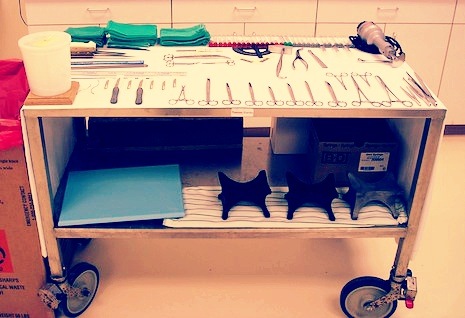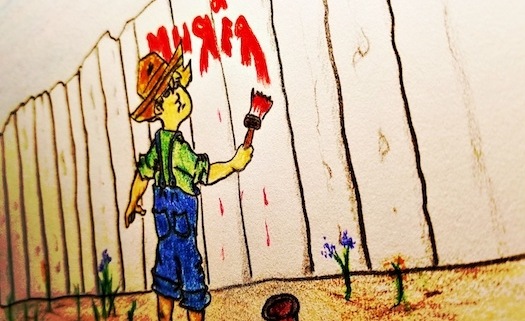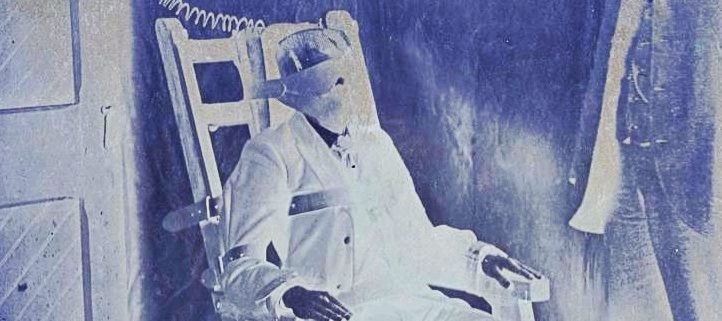For the day when you need just the right word to enhance a crime scene.
A.
Abrasion Collar – The circular pattern and charred, blackened skin surrounding the area/wound caused by a gunshot.
Adhesive Lifter – Any tape-type material containing an adhesive backing that’s used to retrieve prints from a surface.

Adhesive lifters manufactured by Sirchie
Atomized Blood – Patterns of blood stains that appear to have been caused by a fine mist, or spray. Think of the mist that expels from an aerosol can, such as paint or deodorant.
Adipocere – A waxy substance with a texture that’s similar to soap. It’s formed on the dead, decomposing bodies of animals and humans that are typically found in moist, damp locations. Also called Grave Wax.
Antemortem – Before death.
B.
Bilary Tract – Pertains to bile or the gallbladder and the ducts that move bile throughout.
Blow-back – Tissue and blood that’s found on the surface of a firearm that was in close proximity to a victim’s skin when a shot was fired. Blow-back material may also be found inside the barrel of the weapon. For example, a gun barrel is held close to a victim’s temple area when the trigger is pulled. Biological material then “blows back” toward the shooter and the weapon, adhering to those surfaces.
Bradycardia – Abnormally slow heartbeat that sometimes cause dizziness and chest pains due to low cardiac output.
Burking – Smothering a victim in such a manner where there are no telltale signs of the crime. The body is then sold for anatomical dissection.
The term “burking” was named after William Burke, who, in 1815, killed several intoxicated people after following them for the purpose of murdering them. He and a friend participated in the macabre activity. One of the two held a hand over the victim’s nose and mouth, using the other hand to hold the jaw up, while the other sat on the victim’s chest. The held this position until the victim, either a man or woman, died of asphyxia. The sold the fruits of their crimes, the dead bodies, to medical schools in Edinburgh, Scotland.
[Titlow v. Burt, 2010 U.S. Dist. LEXIS 111459 (D. Mich. 2010)].
C.
Cadaveric Spasm – A rare form of muscular stiffening that occurs at the moment of death, continuing into the rigor mortis stage. In fact, it can and has been mistaken for rigor mortis. The cause is unknown, but is thought to occur with violent deaths in conjunction with intense emotion. Also known as postmortem spasm, or instantaneous rigor.
Some scientists state that cadaveric spasm is a myth.
Bedford PJ, Tsokos M. The occurrence of cadaveric spasm is a myth. Forensic Sci Med Pathol. 2013 Jun;9(2):244-8.
However, in an April 2013 article for Forensic Science and Medical Pathology, Dr. Marcella Fierro, , former Chief Medical Examiner of Virginia, said in the 30-years she served as a medical examiner she’d seen the occurrence of cadaveric spasm only three times. Note that she specified “only three times” when speaking of how often she’d seen the condition occur. But she had seen it.
The three cases she spoke of were:
“… a smothered infant who was discovered grasping the asphyxiating blanket enclosing him so tightly in front of his body that it could only be removed with great difficulty.”(1)
Having a surgeon hammer, chisel, and saw away and remove the femur and surrounding bone of my left hip was a bit odd, to say the least. But, I was provided instruction regarding what and how the bone-removal was to take place. I was told, in detail, about the procedure. And, I was assured that a highly trained and well-qualified team would be on hand to make certain that I rested comfortably during and after the removal of my body parts. Drugs were promised. Drugs were administered. Pain was minimal. Drugs were good.
Yes, I had the pleasure of knowing what was to take place and that someone would be on hand to care for my needs.
But there in that hospital bed I thought about the victims of brutal butcherings, where there is nothing to dull physical or emotional pain. There’s no one to comfort the recipient of the poundings and choppings by those who use edged weapons to take apart other humans as if they were no more than store-bought 3-D puzzles.
I thought of the horror of seeing an ax closing in toward the face at a pace of a home run swing delivered by a major league slugger. The sensation of a serrated steak or bread knife as it’s pushed and pulled through meaty flesh and then across hard, brittle bone.
I pondered about seeing a limb—a hand, or a forearm—falling to the floor as jets of squirting red blood sprayed the tile floor and the wife’s favorite “for company only” table cloth.
The dull thud as the ax blade struck the skull just above the ear, over and over again, until chips of bone splintered away to mingle with brain matter and coagulating blood that were already dripping down the walls in wet, slimy clumps of goo.
By the time those deeds are done the poor victim has most likely lost consciousness, sparing them from a pain that’s so intense that words have not yet been invented to describe it.
The assailant continues to meticulously and methodically dismember what is now a corpse. A bloody and unidentifiable pile of flesh and bone. A hand here, a foot there, the head in a paper sack for disposal in the lake, teeth in a neat little pile, and the rest in garbage bags. Well, some went down the toilet until it clogged.
I also recalled researching a book about the murder of a young woman who’d been butchered much in the same way I described above. A family dog found the woman’s femur in a stand of dry weeds next to a sewage treatment plant. The animal brought the human remains home and used it as a chew toy until the owner realized what it was.
Thinking of things in this light, well, my femur extraction was not that big of a deal.
*Warning, the images below are actual photos from a murder case*
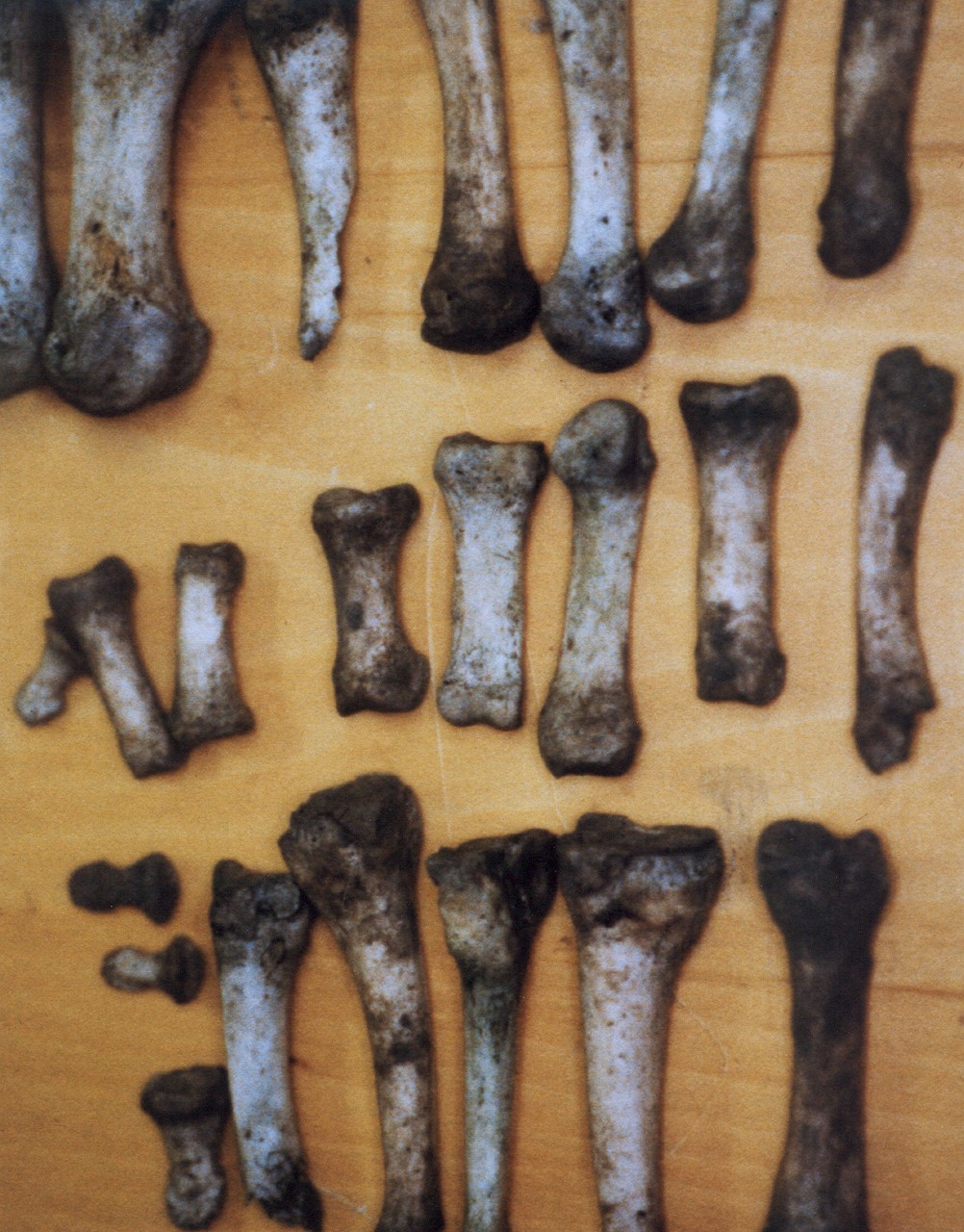
While searching for a victim, these bones were discovered. Sadly, they belonged to the missing woman.
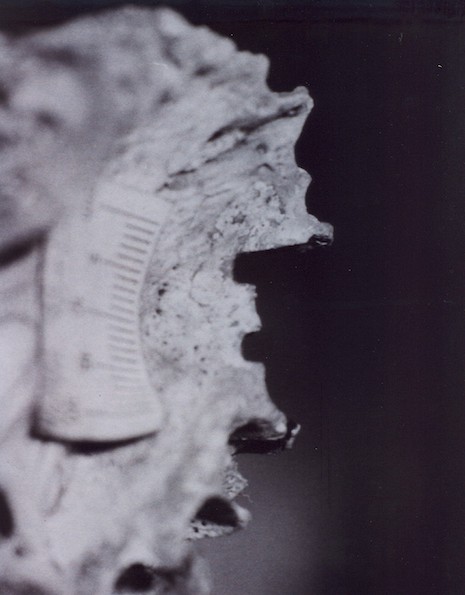
The killer used needle-nose pliers to remove the victim’s teeth, hoping that by doing so identification would be impossible.Notice the square edges where the pliers dug into flesh and bone while removing the teeth.
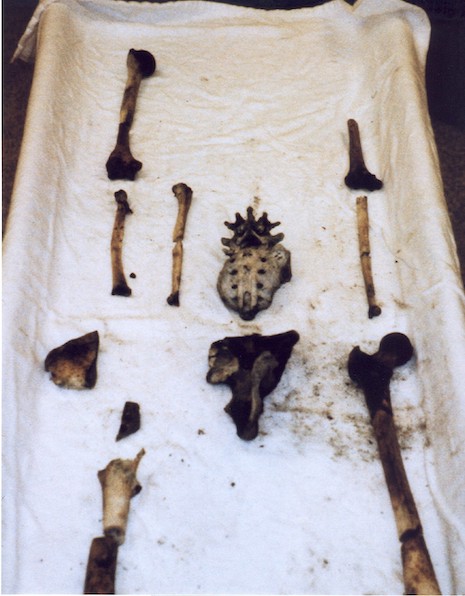
More bone found scattered about the field. Femur at lower right.

Knife blade marks in bone.
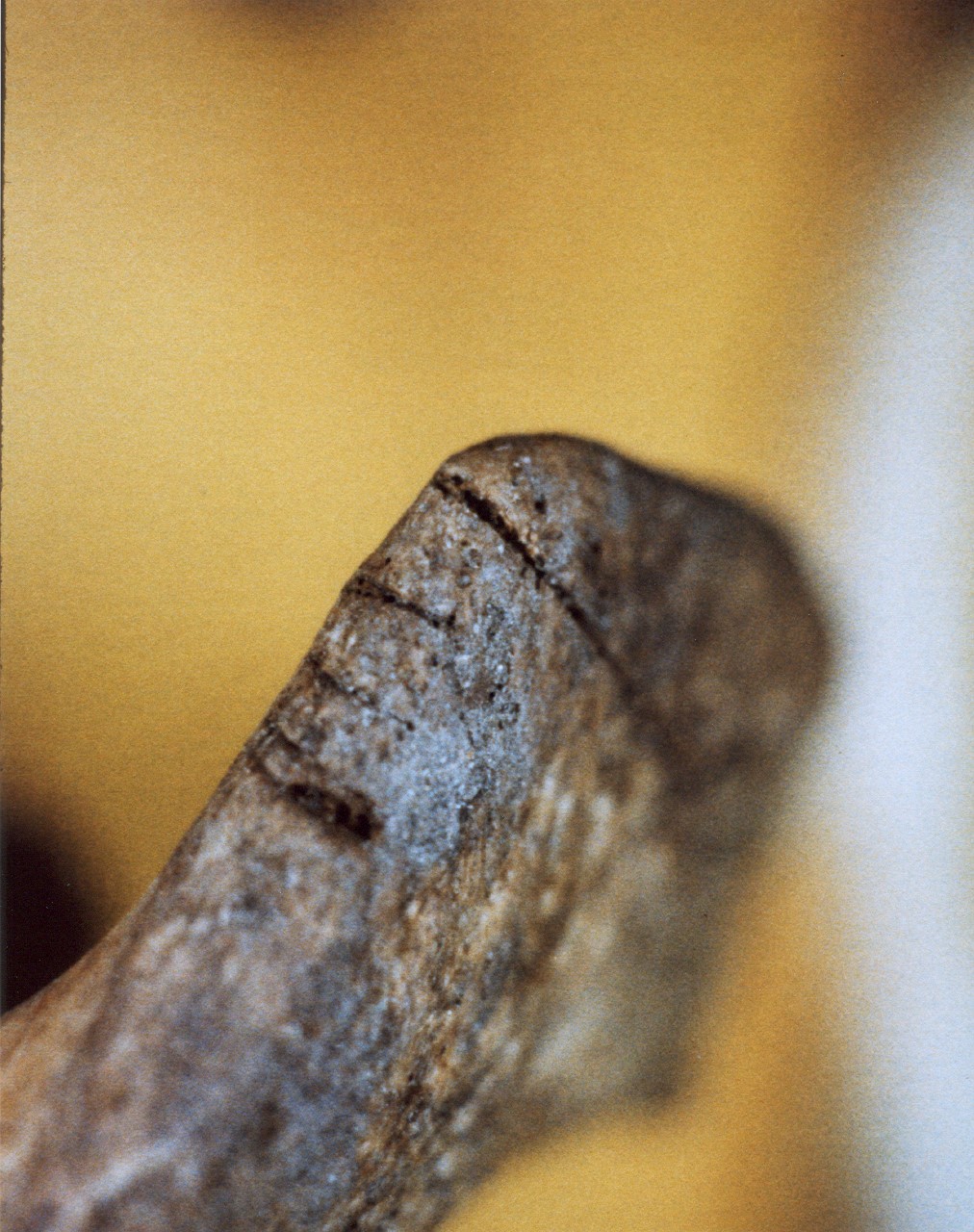
Bone displaying knife cuts
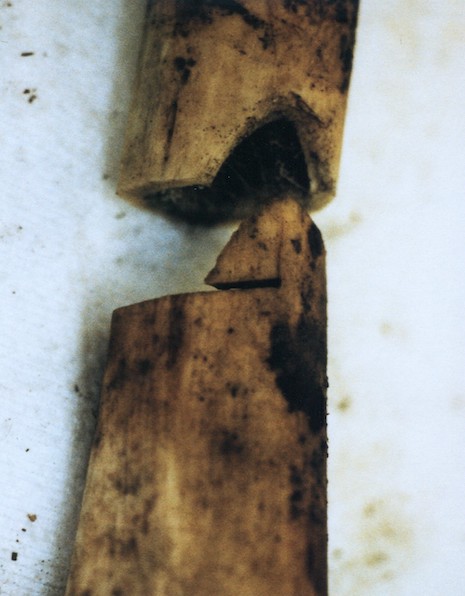
A hack saw was used to partially cut through a bone. The killer then used his hands to finish snapping the bone in two.

Skull displaying serrated knife edge marks caused by “skinning” away the flesh from bone. The killer removed the woman’s face and scalp.
If you like to read about the actual case you’ll find in a true crime anthology called Masters of True Crime: Chilling Stories of Murder and the Macabre. The author of the tale is, well, me. I wrote it after conducting extensive research into this bizarre killing.
Death is an entirely new chapter for our bodies. The final one, actually. And when it happens, either by natural causes, suicide, by accident, or at the hand of a murderer, the end result is always the same—our human forms immediately begin to decompose.
No matter how it happens, when death occurs, the body starts its downward spiral toward skeletonization, first by cooling until it reaches ambient temperature. Next is dehydration, followed by hypostasis/livor mortis/lividity (the gravity-pulled settling of blood at the lowest point within the skin capillaries and other tiny blood vessels—venules, and in the internal organs), rigor mortis, and then autolysis and putrefaction, and possibly mummification, adipocere formation, etc.
For the purpose of this article, and because they appear in many crime crime novels, we’ll explore the two processes of decomposition—autolysis and putrefaction.
Autolysis
Autolysis should be easy to remember for mystery, thriller, suspense, and especially true crime writers. How so? The process can be, in a macabre sort of way, compared to the horrors that took place inside Apartment 213, the residence occupied by a man named Jeffery Dahmer.
With Dahmer in mind, the role of autolysis in decomposition becomes clear. The serial killer from Milwaukee murdered and butchered several victims, keeping some body parts as souvenirs while dissolving others portions in acid. He also pulverized some bone into dust. Included in his ghoulish activities was cannibalism. Yes, he consumed portions of the men he killed and dismembered. The loosely used connection between Dahmer and autolysis is his taste for human flesh, the cannibalism. Yes, our bodies eat their own, sort of.
When death occurs, the body begins its downward spiral toward skeletonization, first by cooling until it reaches ambient temperature. Next is dehydration, followed by hypostasis/livor mortis/lividity (the gravity-pulled settling of blood at the lowest point within the skin capillaries and venules, and in the internal organs), rigor mortis, and then autolysis and putrefaction, or mummification and so on.
Enzymes inside our body’s cells begin digesting their own cells (self-digestion), a sort of reverse Filial cannibalism. This is the process known as autolysis.
Autolysis is affected by the environment. Heat, humidity, surrounding soil and water and even air current (winds) are all factors in the process of decomposition. Autolytic processes are deterred by the cold. In fact, body organs each suffer different rates of autolysis when exposed to low temperatures. Such is the case after death when a body is stored in a refrigerated morgue cold room.
For example, lungs begin to show signs of disintegration at 36 hours after death while stored in the morgue. At 60 hours, the tiny air sacs (alveoli) are demarcated by rows of red blood cells (erythrocytes).
FYI – red blood cells do not contain DNA
At 48 hours, in the cold room, myocardial (heart) fibers begin to show a bit of space/separation. Cells within the heart are no longer as well-defined and their exteriors look a little serrate.
Putrefaction
Putrefaction is decomposition caused by the microorganisms, such as bacteria, that live inside our bodies.
After the first 36 hours or so, the neck, abdomen, shoulders and the head area begin to turn a greenish color. Next to show up is bloating that’s caused the gas produced by bacteria munching away at the body of the victim. Bloating is most visible around the face.
The eyes and tongue begin to protrude as the gases inside push them forward. The skin blisters and peels away (slippage), and hair falls out.
Skin on the hands and feet sometimes slip off, creating grotesque human gloves and socks.
Red blood cells break down causing an effect known as marbling. These “marbled” patterns are quite visible on the face, abdomen, chest and arms and legs.
The body turns greenish-black and fluids begin to seep outward through the mouth, nose, and other natural openings. Cracks in the skin have formed by now and also leak the foul soup.
Grave Wax
Adipocere (aka grave wax), a white-ish, gray waxy substance—adipocere —forms on the face and extremities. After a while, its color changes to a yellow or tannish color. Typically, adipocere takes about three months to develop.
As with autolysis, putrefaction is accelerated by heat and slowed by cool.
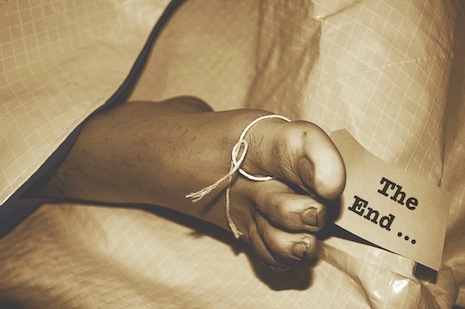
Hangings have been a staple in mysteries for as long as we can remember. The Wild West featured them at high noon. The United States government used them as a means of execution, the last being a fellow from the state of Delaware named Bill Bailey, which finally answers the never-ending question. He’s not coming home, so feel free to stop singing about him.
Dr. John Lofland, Professor of Sociology Emeritus Department of Sociology University of California, Davis, detailed state executions in his original commentary titled, The Dramaturgy of State Executions. He’s an expert on the subject.

Dr. John Lofland is an expert on the subject of executions. He’s also a renowned American sociologist and professor who’s best and widely known for his studies of the peace movement. He’s also a multi-published author (see below), and I have close ties to him because, well, he’s my cousin and, ironically, I sort of loosely stumbled onto his path having witnessed an execution by electrocution/electric chair.
I’ve used bits and pieces of information from Dr. Lofland’s commentary to assist you with understanding hangings and strangulations, the topic of this post.
The History
Hangings got their start in Persia (now Iran) approximately 2,500 years ago. So it’s use as a method of putting the condemned to death is not new. American settlers brought the practice with them from England and continued it’s use to deter bad people from doing bad things, such as murder and rape. Sodomy, practicing witchcraft (or even being suspected of it), and even canceling the birth of a child, such as one born out of wedlock, were also “hanging offenses.”
Hangings “back in the day” were sometimes festive occasions where hundreds and sometimes thousands of people gathered to join the celebration of putting a criminal to death. In 1860, for example, a hanging on New York’s Bedloe’s Island attracted massive crowds of people in the streets. So many that others opted to arrive by boat, including oyster boats, yachts, and large steamers carrying such a large number of people it was thought the ships might sink. Food venders set up tents in the streets. It was the hoedown of all hoedowns, and the tradition continued on for a number of years.
It wasn’t uncommon to hears loud and happy cheers while the condemned person dangled from the rope while kicking their feet and convulsing. The cheers grew even louder when the executioner cut the rope to allow the newly dead to drop to the ground.
At one point in time, it was customary for the executioner to cut off the heads of traitors (post hanging) and then hold them up for the crowd to see.
Sometimes sheriffs cut the hanging rope into small pieces and sold them as souvenirs. If the dying man wasn’t dying fast enough, someone would pull down on his legs to help make for a speedier death.
Condemned men have displayed various reactions when finally arriving at the point of their hangings, such as attempting to dance around the trap door, quickly straddle the opening as the door opened, kicking the executioner, etc. Others, having come to terms with their demise, embraced the moment by gently kissing the rope, delivered a flowery speech, or released a black handkerchief, allowing it float gently to the gallows floor, the symbol to drop the hatch.
Writing a Hanging or Strangulation Scene
Most writers who’ve penned death by rope or other “twisted” cord have never seen a victim of strangulation, or hanging (sometimes they’re the same). And that, of course, makes the task a little more difficult, having to rely on books, TV, film, and the word of experts. So before we look at an actual photo straight from the morgue (I snapped the image), let’s take a moment to discuss why and how something as small as a shoelace has the ability to end a human life.
 While looking firm and sturdy perched on a set of nicely toned shoulders, the neck is actually quite vulnerable to life-threatening injury.
While looking firm and sturdy perched on a set of nicely toned shoulders, the neck is actually quite vulnerable to life-threatening injury.
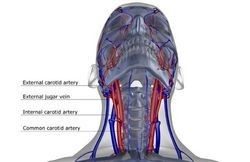 After all, there’s a lot of important stuff packed into a fairly small space—spinal cord, airway, and major blood vessels. And there’s not a lot of protection surrounding those vital body parts. There’s no bony encasement, such as our ribs, that circle around the interior of the neck. Nope, it’s basically just a little muscle and skin that separates the spinal cord, airway, and major blood vessels from harm.
After all, there’s a lot of important stuff packed into a fairly small space—spinal cord, airway, and major blood vessels. And there’s not a lot of protection surrounding those vital body parts. There’s no bony encasement, such as our ribs, that circle around the interior of the neck. Nope, it’s basically just a little muscle and skin that separates the spinal cord, airway, and major blood vessels from harm.
Did you know that hanging is actually a form of strangulation? Well, sometimes hangings may include some spinal cord or bone injury, but basically the death is by strangulation.
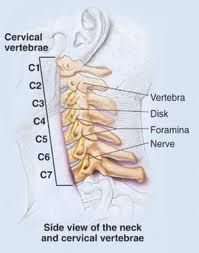 Hangings are either complete (the entire weight of the body is suspended by the neck), or incomplete, where a portion of the body is touching the ground/floor.
Hangings are either complete (the entire weight of the body is suspended by the neck), or incomplete, where a portion of the body is touching the ground/floor.
A judicial hanging (execution) is normally a death by internal decapitation, where the weight of the body combined with the fall causes the neck to break, disconnecting the head (internally) from the body.
A separation at C2 is the classic hangman fracture.
Rarely, as I’ve often read in novels, does a complete, external decapitation occur. However, it is possible to see an external decapitation (the head completely separates from the body—two individual pieces) in cases where the drop is much further than the length of the victim’s body. For example, the victim is 6-feet tall and is dropped from a height of 30 feet or more before the rope tightens.
 The muscles of the neck, such as the sternocleidomastoid muscle, remain intact during an incomplete decapitation.
The muscles of the neck, such as the sternocleidomastoid muscle, remain intact during an incomplete decapitation.
Strangulation by ligature, tool, or mechanism is a little different, however. Death in these instances is normally caused by obstruction of blood flow to the brain, which causes loss of consciousness followed by a loss of muscle tone and finally arterial and airway obstruction. Naturally, other things occur during the time of strangulation, but those listed are probably of the most concern for writers.
However, pressure applied to the neck for mere moments doesn’t always cause death. Martial arts strangle/choke holds often involve a compression of the major neck arteries, causing a temporary unconsciousness. The trachea (windpipe) is not compromised during the application of these techniques.
 This post-autopsy photo below (note the stitching of the “Y” incision) shows a deep ligature mark on the neck (upper left).
This post-autopsy photo below (note the stitching of the “Y” incision) shows a deep ligature mark on the neck (upper left).
The murder weapon was an extension cord, the typical cord found in many homes.
T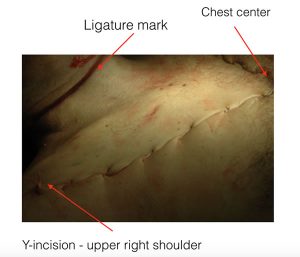 o help orient – the head is to the left, just outside the upper edge of the photo. The Y-stitching begins at the bottom left (upper right shoulder area) and continues to the mid chest area where it’s met by a like incision that began at the upper left shoulder area (upper area of the image) and continued to the chest center. The incision continued down to the area below the navel (bypassing the bellybutton).
o help orient – the head is to the left, just outside the upper edge of the photo. The Y-stitching begins at the bottom left (upper right shoulder area) and continues to the mid chest area where it’s met by a like incision that began at the upper left shoulder area (upper area of the image) and continued to the chest center. The incision continued down to the area below the navel (bypassing the bellybutton).
This post-autopsy photo (note the stitching of the “Y” incision) shows a deep ligature mark on the neck (upper left).
The above image is not of the mysterious Bill Bailey. No, he’s still missing. Perhaps “Frankie and Johnny” know of his whereabouts. Ah, how many of you know what the heck I’m referring to in this half-baked riddle?
*This particular autopsy was conducted in the state of Ohio, where procedure may vary from the area where your story is set.
Suicidal Hangings
As a police detective, I’ve seen a few suicides and suicide attempts. They’re not a pretty sight, and there’s a different and noticeable “feel” at those scenes than what’s experienced when stepping into a location where someone was murdered. They’re both emotional, nearly palpable experiences. But suicides … there’s the intense sensation of the misery, sorrow, sadness, and extreme loneliness—what the victim was going through at the time they ended their time on this planet. For a moment, a brief flutter deep in the gut, you sometimes feel as if you’re standing there in their shoes.
It’s especially bad when the suicide is that of a child. Here’s post where I describe one of those scenes. It was a tough one.
Unlike state executions where death is practically instant due to the breaking of the neck as a result of the sudden fall, suicide hangings typically take approximately 8-10 minutes before the deed is all said and done, and the death is typically caused by asphyxiation due to compression of the airway and major blood vessels of neck (see image above).
Should the victim change their mind and halt the process mid-act, or if they’re rescued by someone, here’s what they could expect to happen to their bodies immediately thereafter.
- Respiratory distress
- Pulmonary edema (fluid in the lungs)
- Convulsions
- Elevated intra cranial pressure
- Unconsciousness
Post hanging attempts require adequate oxygenation and restoration of an adequate blood flow to the brain (hyperventilation sometimes helps the process).
Tracheal intubation and/or mechanical ventilation are often needed to maintain oxygen supply. Patients may require aggressive oxygen therapy and must be monitored closely because pulmonary edema could occur even after few hours following the suicide attempt. Merely because they’ve started breathing on their own and appear to be “coming around” does not mean that all is well. Nor does it mean the victim(s) in your stories are completely out of the woods at that point.
Hey, when you need that touch of added tension to “breathe life” into an otherwise somewhat dull scene, well, here you go …
 Dr. John Lofland is the author and coauthor of various works detailing social movements, social psychology, and research methods. Some of his writings include, Symbolic Sit-ins, Doing Social Life Deviance and Identity, Analyzing Social Settings, and Protest: Studies of Collective Behaviour and Social Movements.
Dr. John Lofland is the author and coauthor of various works detailing social movements, social psychology, and research methods. Some of his writings include, Symbolic Sit-ins, Doing Social Life Deviance and Identity, Analyzing Social Settings, and Protest: Studies of Collective Behaviour and Social Movements.
According to Wikipedia and a bit of our family history, John’s book, Doomsday Cult, “is considered to be one of the most important and widely cited studies of the process of religious conversion, and one of the first modern sociological studies of a new religious movement.”
Dr. John Lofland and I both are related to another Dr. John Lofland.
The early Dr. Lofland was the first official poet for the State of Delaware and authored The Poetical and Prose Writings of Dr. John Lofland, the Milford Bard. I have a copy.

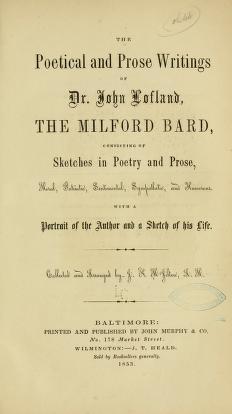
In 1830 John Lofland accepted a challenge from Edgar Allan Poe at the Stars and Stripes Tavern on Water St. in Baltimore Md. The challenge was to see which of the two could write the greater number of verses. Poe lost to Lofland in the marathon contest and was obligated to pay for dinner and drinks for his good friend. This is proof a Lofland received the first ever Edgar Award, dinner and drinks from Poe himself!
Thoughts
by Dr. John Lofland, The Milford Bard
Oh! Liberty, how lovely are thy charms,
Thus to call forth embattling bands to arms!
T’ avenge his country’s wrongs, her rights to save,
To win a glorious garland, or a grave;
To rend the chains of cheerless slavery,
To give unborn millions liberty;
To dash the sceptre from the despot’s hand,
Heroes have nobly bled, and patriots plann’d…
Oh! War, what horrors follow in thy train,
What scenes of grief, of dark despair and pain?
Methinks I see the dying and the dead,
Adown this hill, upon their grassy bed;
I hear the cry of wounded men, in vain,
Calling on wives and children, o’er the main;
Calling on wives and children, they no more
Shall see on life’s now fast receding shore;
I see forms of those who died, that we
Might live and long enjoy liberty.
Sometimes it’s the tiniest of details that offer the extra oomph needed to send a good story over the edge to “can’t-wait-to-turn-to-the-next-page” greatness. Unfortunately, or fortunately, depending on the point of view, many writers of whodunits and other such crime novels have not had the opportunity to visit an actual crime scene where the victim du jour has been murdered.
Sure, there are tons of books that describe the experience, and there are many writers conferences around the country that feature experts who detail the steps and equipment used to solve crimes. But a list of procedures and pictures of investigational do-dads don’t quite add the over-the-hump material that sends a tale into sensory overdrive.
Writers must express the sights, sounds, odors, and emotions that detectives experience as they process a crime scene. Actually, what I just described is what investigators should do before entering a crime scene—look, listen, and smell.
Those are three very important initial assessments, and that’s so for a variety of reasons.
- Look – Scan the area visually for anyone who may be involved with the crime. Sometimes people enjoy watching the police as they work, seeing if they’ll stumble upon something that may incriminate them. Also, it’s a safety issue. This is a time to trust no one because even family members of the victim(s) could become violent. One of the worst fights of my career occurred while attempting to protect a murderer from the victim’s family. There were two officers against a dozen angry, emotional, and violent people trying to go through us to get to the killer.
Be on the lookout for animals. Wildlife may be on the prowl for, as unpleasant as this sounds, a meal. Therefore, the officer may need to call upon animal control or area game wardens for assistance. The same is true for family pets who will often stop at nothing to safeguard their domain and/or the lifeless bodies of their owners.
Make note of any vehicles scene driving through or leaving the area.
Notice insect activity.

Visually scan the entire area for secondary crime scenes, areas where evidence of the main crime is located.
For example, Tom Ishotem killed Bill Isdead, using a hollow point fired from a .357. Tom ran twenty yards and then tossed the revolver into Ms. Irene Iseenitall’s front yard next to her blue-ribbon-winning salmon-pink Barbara Bush hybrid-tea rose bush she ordered from the Rogue Valley Roses over in Oregon.
Then the murderer hopped the hedges and disappeared into the night. Actually, he landed in a manure pile in Harvey Jenkins’ hog pen, but it sounded far more cool to say he vanished into the darkness, right?
Anyway, Ms Iseenitall’s front yard is considered a secondary crime scene because evidence, the gun, was found there. Remember, the spot where the crime actually takes place is “the scene of the crime.” All other locations where evidence is found are secondary crimes scenes.
2. Listen – Be alert for the hissing of broken gas lines, snarling dogs, and even the rattle of snake’s tail. After all, the cause of death could be the bites of a baker’s dozen of rattlesnakes. Listen for the sounds of footsteps and moving brush. The crackling of twigs. I once discovered a killer hiding in the tangle of bushes because he’d moved slightly which caused a thin branch to snap when his shirt caught a sharp end of the limb. Had he not done so (it was nighttime and raining) he may have gotten away.
3. Smell – Again, take a moment to put your nose to work in the event there’s a gas leak. What about the lingering odor of a cologne or perfume? The fresh scent of gunpowder? But whatever you do, do NOT write that your hero smelled cordite. NO, NO, and NO! The manufacturing of that stuff ceased at the end of WWII. Again, NO!
Be alert for the odor of toxic chemicals—meth labs or even biological weapon manufacturing.
4. The first responder should ALWAYS assume the crime is currently in progress until they’re certain it is not. All too often officers are surprised by the guy behind the door (hypothetically) with a knife. However, that’s exactly what happened to my rookie butt one night when I stepped into a room, assuming the bad guy was either under the bed or in a closet. Thankfully, my experienced partner stopped the guy from inserting a serrated-edge steak knife between my shoulder blades. That’s a lesson I’ve not forgotten.
So, yes, tiny details, such as the sweet scent of a lovely Barbara Bush hybrid tea rose, the salmon pink ones, mingled with the odor of escaping propane from a loosened copper fitting, along with the putrid funk of Mr. Bill Isdead’s decomposing corpse, a scent that brings to mind a forgotten Purdue chicken left to thaw in a kitchen sink for two solid weeks, added to the chemically-offensive meth lab concoctions, would certainly add a bit more “flavor” to a tale than simply writing …
“Detective Johnson approached the scene with caution before entering the room where the body of Mr. Billisded lay dead. He wondered, whodunit.”
Look, Smell, and Listen!
Have you ever read what you thought was a fantastic book, the kind that forces us to read into the wee hours of the morning, not wanting to stop because the writing is so doggone good? But then on page 1,617, well, there it is, the sentence that makes us scream like the shopper on Black Friday who lost the last 100-foot-flatscreen Kawasaki Supersonic television to the old lady with the great left jab who immediately zipped over to the checkout counter on her suped-up Hoveround with YOUR TV strapped to her back.
Yeah, you know those books. The stories written by the author who figured no one would notice that he didn’t know the difference between a revolver and a semi-automatic pistol. Or that cordite hasn’t been used in the manufacturing of ammunition since the last days of WWII. Yep, those books.
We’ve all heard (over and over and over again) about fake news, right? You’ve even heard me mention the nonsensical reporting so often seen floating around the internet. Well, the use of incorrect firearm and other forensic terminology and information has the same stink to it as does the news reporter who kneels down in a shallow puddle of water to make it seem as if he’s standing in raging floodwaters.
So let’s have a fresh start today and we’ll do so by clearing a bit of the stinky faux pas from our writing. We’ll begin the funk-cleansing by quashing a few details about blood evidence. First, up …
Some writers have their crime-solvers rush into a murder scene while soaking the area with a luminol-filled power washer. They spray and spray until every surface—walls, ceilings, and even the family dog and Ralph the goldfish are dripping with the glowing liquid.
Others, well, their detectives have the uncanny ability to merely look at blood droplets and immediately know its type and what the bleeder had for dinner and the exact time the red stuff spattered the family portrait hanging above the mantle.
You put your left eye up, you put your left eye down.
You put ’em both together and then you look all around.
That’s what it’s all about!
~ Sung to the tune of The Hokey Pokey.
So, as the peppy little jingle above indicates, investigators should always examine a scene visually before taking the first step inside. This includes looking up. See if there are bloodstains there. Any brain matter? Bullet holes? Insects?
Next, the walls and for the same items of evidence and/or clues.
The floor and the body, if that’s where it was found. Of course, the victim should be the first concern. After all, he or she just might still be alive and need prompt medical attention. Oh, and a quick check for the suspect is always a good idea. No need to take a bullet or stab wound in the back if not absolutely necessary. Priorities!
Then look all around, and do examine the smallest of details. Evidence, as any seasoned investigator will tell you, is sometimes found in the most unlikeliest of all places.
Crime-scene searches must be methodical and quite thorough. Every single surface, nook, and cranny must be examined for evidence, including doors, light switches, thermostats, door knobs, etc.
For example, removing the plastic light switch or receptacle covers reveals an ideal hiding spot for small evidence.

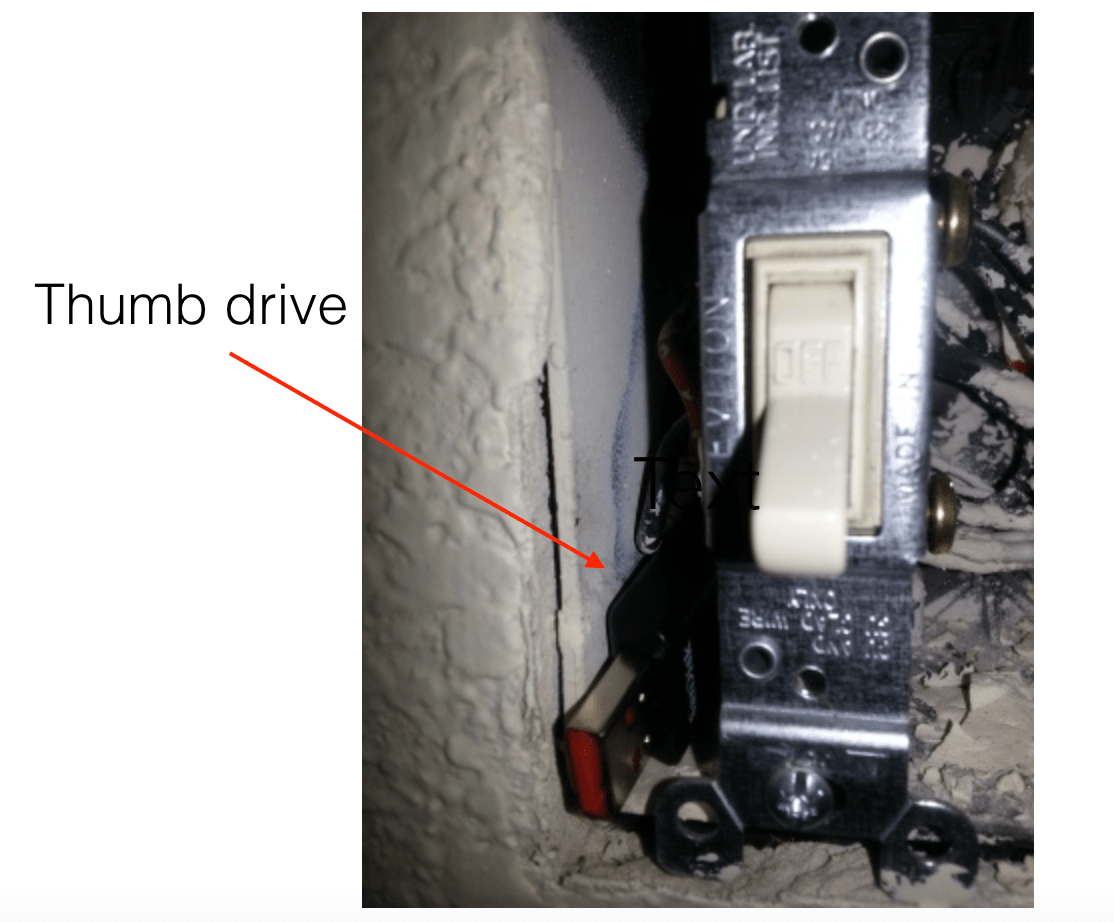
First responders can be a homicide detective’s worst nightmare!
Was evidence disturbed or altered when first responders arrived at the scene? Did they open or close windows and doors? Did they walk through blood or other body fluids?
Investigators must determine if the body has been moved by the suspect. Are there drag marks? Smeared body fluids? Transfer prints? Is there any blood in other areas of the scene? Is fixed lividity on the wrong side of the body, indicating that it had been moved after death
Does the victim exhibit signs of a struggle? Are there defensive wounds present on the palms of the hands and forearms?
Okay, back to the blood found at the scene. Your detective has detected a bright red and wet substance spattered across a bedroom wall. The victim ju jour is spread eagle on the floor beneath, obviously dead due to a large gap between the eyes. Therefore, the reasonable assumption is that the material dotted and smeared across the wall is indeed blood. But this must be verified.
The procedure for identifying the red, wet substance is not like we see on television.
Officers do not dig through their crime scene kit to pull out a UV light, shine it on the red drops and drips and then turn toward the camera to say, “It’s blood. Type O. She consumed orange juice and a ham sandwich three hours before a left-handed shooter, probably the waiter at the Golden Horseshoe Lounge, popped a cap into her oval-shaped head. I know this, TV viewers, because I magically saw the DNA and it’s a match for all of the above. I’ll be available for autographs later tonight in the lobby of Bucky Bee’s Motor Lodge out on Route 66.”
For starters, unlike saliva and semen, blood doesn’t fluoresce under UV light. Instead, the appropriate light source for viewing (and photographing) blood evidence is an infrared light source. Infrared light is at the wavelength between visible light and microwave radiation. It is invisible to the naked eye.
To avoid altering, contaminating, or destroying blood’s usefulness as evidence, a savvy detective must first determine the reddish-brown substance is blood and not spilled, leftover pasta sauce. To do so, investigators conduct a simple presumptive test such as the Leuco-Malachite DISCHAPS test. This is a field test kit that contains chemical filled ampoules that, when exposed to the evidence, displays an intense blue/green color reaction in 3 seconds if blood is present.
Remember, swab a small sample for testing. Do NOT destroy the entire piece of evidence by exposing it to the testing material. Test only the swab!!
Now that your protagonist has determined that blood is present, the next step is to photograph the evidence/area where blood was found.
Luminol, the chemical used to detect blood at crime scenes, reacts with the iron in hemoglobin. It emit a blue glow that can then be photographed as evidence. It’s helpful with locating the presence of blood even after the place has been thoroughly cleaned. However, it has its limitations because the chemical dilutes blood to the point where DNA is destroyed.
The use of various filters on infrared cameras helps to reveal evidence that can only be seen with specific areas of the infrared spectrum. For example, when capturing images of blood, filters coated with a protein that is found in both egg whites and blood plasma—albumin—are often used.
Other filters are available to detect drugs, fingerprints, and explosives.
Bone fragments and teeth are visible using both UV and blue light. Crack cocaine also fluoresces under blue light.
Those of you who attended the fabulous presentation by Sirchie at the 2018 Writers’ Police academy saw the use of these demonstrated in real time.
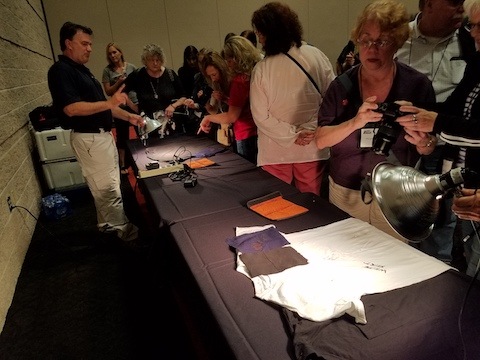
To recap in simpler terms:
- Examine the crime scene visually before entering.
- Visually inspect the areas above, below, and around so as to not miss evidence that may otherwise go undetected. Looks in odd places!
- Conduct your search in a methodical manner. Be patient.
- Identify possible bloodstains
- Use presumptive test kits to determine if stains are indeed blood and if they’re from a human.
- Do NOT destroy am entire stain during testing. Use a swab to capture a small sample and then test the swab, NOT the entire stain.
- Make certain to preserve portions of the blood sample for other testing—DNA, etc.
- Use proper light sources for locating and photographing blood.
- Blood does not fluoresce under UV light.
- The appropriate light source for viewing (and photographing) blood evidence is an infrared light source.
- Filters coated with albumin are used for photographing blood. Other filters are also available.
- Sirchie is the Global Leader in Crime Scene Investigation and Forensic Science Solutions; providing quality Products, Vehicles, and Training to the global law enforcement and forensic science communities.
*Remember the name “Sirchie” because you’ll soon be hearing more about them. Very, very soon. The news is exciting!

I think it’s fairly safe to say that no one writer has enjoyed a good poison more than the “Queen of Crime,” Agatha Christie. In fact, Dame Agatha Mary Clarissa Christie knew so little about guns and ballistics that she maintained the use of toxins as a primary mode of murder throughout her career as an author.
Christie once worked as an apothecary’s assistant and, to continue in the role, she had to pass required examinations. To assist her, co-workers tutored her in chemistry and pharmacy. In addition, she received private tuition from a commercial pharmacist who later made an appearance as the pharmacist in her tale The Pale Horse.
Her knowledge of apothecary was so detailed that it once received a glowing review—“This novel has the rare merit of being correctly written”—in the Pharmaceutical Journal and Pharmacist.
Yes, she wrote what she knew, yet, if she came across a topic of which she was unsure she didn’t hesitate to seek help, such as the time she contacted a specialist to inquire about about putting thalidomide in birthday-cake icing (How much should the killer use? How long before the effects of the poison would begin to show?).
Christie was definitely good at what she did and she was a pro at weaving fact into fiction without making it seem like we were reading the factual stuff straight from a textbook like we often see today in some books.
I like to point to Jeffery Deaver as a modern day example of a true pro who knows his stuff and who knows how to cleverly interject very real facts into a tale.
 With each book, Deaver enters into a grueling research period, examining every minute detail, and he conducts this research sometimes for months on end before he sets the first word to paper. But when he does, the result is a true masterpiece of believable make-believe. In fact, something, a bit of factual information I found in his book Roadside Crosses was the starting point for a section in my book on police procedure.
With each book, Deaver enters into a grueling research period, examining every minute detail, and he conducts this research sometimes for months on end before he sets the first word to paper. But when he does, the result is a true masterpiece of believable make-believe. In fact, something, a bit of factual information I found in his book Roadside Crosses was the starting point for a section in my book on police procedure.
A character in Roadside Crosses mentioned using a write blocker when examining a computer hard drive, one that had been submerged in a body of water. Well, at the time I was planning the section on computer crimes and what I seen in Jeff’s book was the catalyst that prompted a portion of that particular section.

By the way, a write blocker is used by forensic investigators when they need to have a look inside a suspect’s computer. The device allows data to travel only from the suspect device to the computer copying the information, not the other way around. The analogy I used in my book was to equate the write blocker with a foot valve inside a well. The valve allows water to flow into a home but doesn’t permit it to run back into the well.
Back enough dilly-dallying, let’s return to Christie and her use of poisons, and she used several, such as strychnine (The Mysterious Affair at Styles), thallium (The Pale Horse), digitalis, cyanide (Sparkling Cyanide). She also used coniine (Five Little Pigs), which I find interesting because it’s an alkaloid extracted from hemlock. Spooky, huh?
However, today I’d like to delve a bit into Dame Christie’s use of arsenic since the toxin is one so many writers seem to gravitate toward. I know I see and hear and receive numerous written inquiries about it’s use. Sure, I know people often use me to get to Denene, my microbiologist/scientist wife who’s an expert on bioterrorism, but, as the Lynyrd Skynyrd song goes, “I Know a Little.”
“Say I know a little
I know a little about it
I know a little
I know a little about it
I know a little about love poison
And baby I you can guess the rest”
My knowledge of arsenic as it relates to the crime world is twofold—its use to kill, and the presumptive test to see if arsenic or other heavy metals are indeed present in someone’s system, the alert that further testing is required to determine the toxin that caused a victim’s demise. It’s the latter, the presumptive test that I’m sharing with you today, and here it is in a very brief and tiny and, hopefully, understandable nutshell.
The Reinsch Test
The Reinsch Test uses a strong acid, and copper, to identify the presence of arsenic, antimony, bismuth, and mercury. The metallic copper, when in the presence of concentrated hydrochloric acid, reduces arsenic (also antimony, bismuth and mercury) to its elemental form. If arsenic is present when the copper is introduced to the acid, it adheres to the copper as a visible but dull black film.
The Process
- First, obtain specimens for testing. Urine, gastric contents, or liver samples are the preferred specimens.
- Using a copper spiral of#20 gauge, or a foil copper strip, the technician/scientist, carefully winds the copper around a glass rod or a pencil. Next, the copper is cleaned by immersing it in concentrated nitric acid for a few seconds. The tech then immediately removes it and dunks the cleaned copper into a container of water. If the cleaning process was successful, and it should be, the copper will now appear as bright and shiny as a brand new penny.
- An arsenic reference solution must then be prepared by dissolving predetermined amounts of arsenic trioxide and sodium hydroxide. Then dH2O (distilled water) is added to the mix. The solution is neutralized with concentrated HCl (hydrochloric acid) and more dH2O.
- Place clean copper spirals (the ones coiled by wrapping around the pencil) into separate beakers or flasks.
- Place 20 mL urine, approximately 10-15 g minced tissue in 20 mL dH2O, or a specific amount gastric contents dissolved in 20 mL dH2O into a labeled beaker. By specific, I mean a number that evenly divides another number. Precisely speaking, this number/amount is an “aliquot” of gastric contents. An aliquot is a number that evenly divides another number, such as the number 5 is to the number 20.
I first heard this term, aliquot, back during the time when I was in a breathalyzer certification course. It appeared again when I was observing an autopsy performed by Dr. Marcella Farinelli Fierro, Chief Medical Examiner of Virginia, who was the inspiration for Patricia Cornwell’s books and for her protagonist Dr. Kay Scarpetta. The term has been embedded in my mind for forty years, give or take.
Okay, I’m rambling again. Back to the procedure.
6. Place 20 mL negative control urine in two separate beakers. Add 40 μL of 1 mg/mL of the premixed arsenic reference solution (from step 3 above).
7. Slowly and gently add 4 mL concentrated HCl to each beaker.
8. To avoid breathing or contacting the vapors, under a hood, heat the solutions to a gentle boil for approximately one hour. Then add 10% HCl as necessary to maintain the original volume. Do not allow the solution to dip below the original level.
9. After one hour, remove the copper coils and rinse with distilled water. If the copper coils in the unknown samples become gray, black, or silvery, then the result is a presumptive positive for the presence of heavy metal.
10. BINGO! You’ve now confirmed your suspicions. The victim was indeed poisoned. However, you’re still not sure of which heavy metal is the culprit, unless, of course, you found the victim’s wife holding a half-empty box of rat poison while standing over her deceased husband.
The next step would be to send a sample to a qualified laboratory where it would then undergo further testing to determine which heavy metal was used to kill the victim du jour.
11. Tie up loose ends and then issue a warrant for the killer.
12. Arrest the suspect.
13. Go home, crank up the volume on track four of Skynard’s Street Survivor disc (I Know a Little), and settle in to read Roadside Crosses.
14. Take a break from reading to ponder the Georgians and Victorians who many believed were killed simply because they were particularly fond of the colors red and green—two colors whose components in those days were made of arsenic compounds. Therefore, many common items were thought to have become instruments of death, including clothing and kids toys.
For many years people believed a very real danger of arsenic poising was due to the common, ordinary wallpaper used in those days. Why? Again, due to the extreme popularity of red and green colorings. To stick the paper to walls and other surfaces, homebuilders back then used a paste of flour and water, and when the paste later became moist, such as in humid and/or damp climates, became an ideal breeding habitat for mold. And, in this macabre chain of perhaps fictional circumstances, some molds transformed the arsenic into a gas called trimethylarsine. This stuff then was released arsenic from the paper which was then inhaled by humans who occupied the space.
However, even though arsenic was used in the wallpaper colorings, some scientists today do not believe that arsenic was to blame for those untimely deaths. In fact, it’s been stated that the illnesses that caused many of those deaths were simply misunderstood and misdiagnosed illnesses—arsenophobia that ran wild in 19th century Europe—merely because something in the house smelled odd at the time someone died of unknown causes.
While we’re alive our body temperatures are determined by metabolism. It’s a different ballgame, though, once the bucket is kicked.
After death, the body’s core temperature remains fairly constant for a couple of hours. Then it begins to cool by radiation, conduction, and convection, at a rate of 1.5 degrees per hour, until it reaches the ambient temperature—20-30 hours later.
However, investigators shouldn’t use the body temperature as the sole means of determining when a victim died. There are factors that could, and do, alter the natural cooling process.
When the “moment” arrives and the victim succumbs to wounds, illness, or natural death, there are elements that may affect the cooling rate of the body, such as:
- Ventilation: A room that’s well-ventilated could actually speed up the rate of cooling by increasing the rate of evaporation.
- Humidity: A body in a humid location cools at a slower rate than one in a hot, dry climate.
- Insulation: A body that’s wrapped in something (including excess body fat) cools slower than one that’s left out in the open.
- Surface temperature: A body lying on a hot surface will cool at a slower rate than one that’s found lying on a cold surface.
And, of course, a body in a hot environment cools much slower than one found lying in a in the snow, or a vat of ice cubes.
There are also factors that come into play that could alter the body temps even before death occurs, such as:
- Consumption of drugs, extreme physical activity, and fever could all increase the body temperature.
- Hypothermia could lower the body temperature.
These factors would change the length of time it takes a body to reach the surrounding air temperature.
Finally, the rate of cooling also affects other “after death” processes, such as rigor mortis—heat speeds up rigor and cold slows it down.
By the way, other factors may also speed up rigor, such as extremely violent exertion prior to death, and alkaloid poisoning. Factors that could slow the rigor process are hemorrhaging by exsanguination, and arsenic poisoning, to name a couple.
And … a handy rule of thumb for decomposition:
One week in air = two weeks in water = eight weeks under ground.
The first hours of a murder investigation are crucial to solving the crime. I say this because as time passes memories fade, evidence can become lost or destroyed, people have the opportunity to develop excuses, stories, and alibis, and the bad guys have the time to escape arrest.
Here’s a handy list to keep on hand that could help solve the cases investigated by the detectives in your stories. Keep in mind that time is of the utmost importance! So, in no real order, off we go …


Serving a search warrant. Knock, knock!

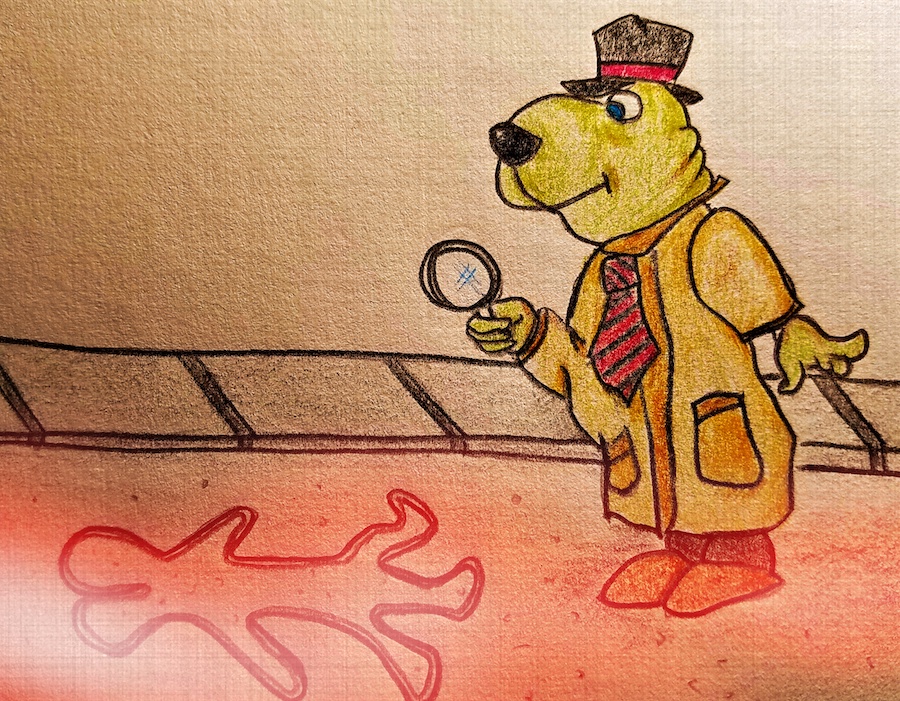
Investigators start the search at the scene and then extend the search area as needed.

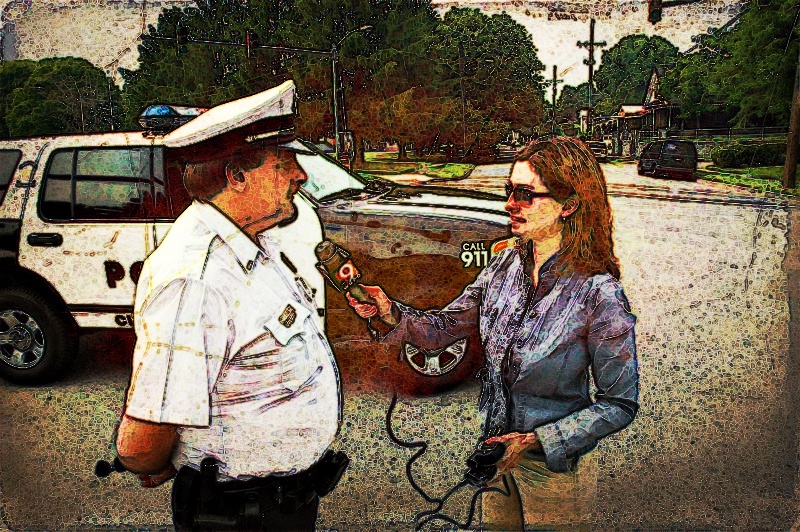
Police Public Information Officers (PIO) are the direct line of communication between departments and the public.


It’s important to keep the bosses informed. They do not like to be blindsided with questions they can’t answer.

And then it’s time for …

*Remember, no list is all inclusive since no two crimes are exactly the same. And, no two detectives operate in the exact same manner.
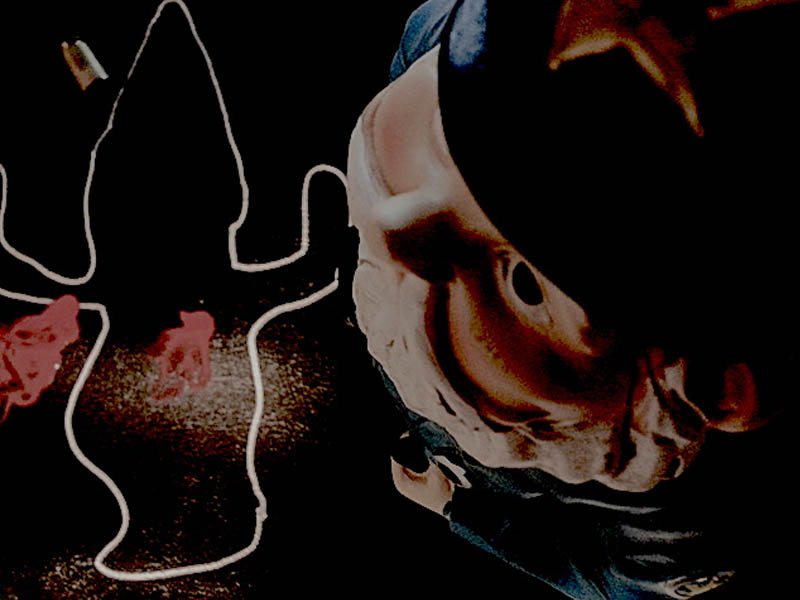
Prisoners are constantly scheming and devising ways to beat the system, and death row inmates in South Carolina found a way to essentially put the brakes on executions. How’s that for ingenuity?
Officials in South Carolina, bless their hearts, believed condemned killers should have the option as to how they’d die—lethal injection or electric chair. Well, it goes without saying that given the choice of being fried like a chicken for a Sunday dinner or to lie down on a padded gurney where a medical person injects enough drugs to initiate a very long nap in the great beyond, the folks residing on death row picked the injection over the suped-up jumper-cable-powered chair. A no-brainer.
No Access to Drugs
Unfortunately for the state but a stroke of good fortune for the prisoners, in 2011, South Carolina was permanently denied access to the drugs to perform lethal injections. Therefore, by opting for lethal injection, a process inmates knew could not be carried out, those prisoners prolonged their lives for eternity. They were condemned to die but the state had no means to make it happen. Until …
State officials recently held a vote to eliminate lethal injection as an option for execution, making the use of the electric chair mandatory. The results of the vote … Yes=26. No=12. The proposal now goes to the House where it expected to pass easily, meaning it will soon be time to fire up Old Sparky. The prisoners will no longer have a choice. They will be electrocuted until dead.
South Carolina is one of only nine states that allow electrocutions. A couple of states have ruled the use of the electric chair is unconstitutionally cruel. I’ve witnessed an execution by electrocution. It’s not pretty, but it works.
Execution: It was April 27, 1994 at 11:13 pm. when I looked into the eyes of a serial killer and then watched him die.
Timothy Wilson Spencer began his deadly crime spree in 1984, when he raped and killed a woman named Carol Hamm in Arlington, Virginia. Spencer also killed Dr. Susan Hellams, Debby Davis, and Diane Cho, all of Richmond, Virginia. A month later, Spencer returned to Arlington to rape and murder Susan Tucker.
Timothy W. Spencer, The Southside Strangler
Other women in the area were killed by someone who committed those murders in a very similar manner. Was there a copycat killer who was never caught? Or, did Spencer kill those women too? We’ll probably never learn the truth.
Spencer was, however, later tried, convicted, and sentenced to die for the aforementioned murders. I requested to serve as a witness to his execution. I figured if I had the power to arrest and charge someone with capital murder, then I needed to see a death penalty case through to the end.
On the evening of Spencer’s execution, corrections officials met me at a state police area headquarters. I left my unmarked Chevrolet Caprice there and they drove me to the prison. We passed through the sally port and then through a couple of interior gates, stopping outside the building where death row inmates await their turn to die.
Once inside, I was led to a room where other witnesses waited for a briefing about what to expect. Then we, in single file, were led to where we’d soon watch a condemned man be put to death.
The room where I and other witnesses sat waiting was inside the death house at Virginia’s Greensville Correctional Center. At the time, the execution chamber was pretty much a bare room, with the exception of Old Sparky, the state’s electric chair, an instrument of death that, ironically, was built by prison inmates.
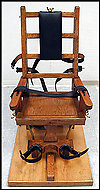
Old Sparky, Virginia’s electric chair, was built by inmates.

State executions in Virginia are carried out at Greensville Correctional Center.
The atmosphere that night was nothing short of surreal. No one spoke. No one coughed. Nothing. Not a sound as we waited for the door at the rear of “the chamber” to open. After an eternity passed, it did. A couple of prison officials entered first, and then Spencer walked into the chamber surrounded by members of the prison’s death squad (specially trained corrections officers).
I later learned that Spencer had walked the eight short steps to the chamber from a death watch cell, and he’d done so on his own without assistance from members of the squad. Sometimes the squad is forced to physically deliver the condemned prisoner to the execution chamber. I cannot fathom what sort mindset it takes to make that short and very final walk. Spencer seemed prepared for what was to come, and he’d made his peace with it.
Spencer was shorter and a bit more wiry than most people picture when thinking of a brutal serial killer. His head was shaved and one pant leg of his prison blues was cut short for easy access for attaching one of the connections (the negative post, I surmised). His skin was smooth and was the color of milk chocolate. Dots of perspiration were scattered across his forehead and bare scalp.
Spencer scanned the brightly lit room, looking from side to side, taking in the faces of the witnesses. I wondered if the blonde woman beside me reminded him of either of his victims. Perhaps, the lady in the back row who sat glaring at the condemned killer was the mother of one of the women Spencer had so brutally raped and murdered.
After glancing around the brightly lit surroundings, Spencer took a seat in the oak chair and calmly allowed the death squad to carry out their business of fastening straps, belts, and electrodes. His arms and legs were securely fixed to the chair. He looked on, seemingly uninterested in what they were doing, as if he’d just settled in to watch TV, or a movie.
I sat directly in front of the cold-blooded killer, mere feet away, separated only by a partial wall of glass. His gaze met mine and that’s where his focus remained for the next minute or so. His face was expressionless. No sign of sadness, regret, or fear.
The squad’s final task was to place a metal, colander-like hat on Spencer’s head. The cap was lined with a brine-soaked sponge that serves as an excellent conductor of electricity.
I wondered if Spencer felt the presence of the former killers who’d died in the chair before him—Morris Mason, Michael Smith, Ricky Boggs, Alton Wayne, Albert Clozza, Derrick Peterson, Willie Jones, Wilbert Evans, Charles Stamper, and Roger Coleman, to name a few.
Morris Mason had raped his 71-year-old neighbor. Then he’d hit her in the head with an ax, nailed her to a chair, set her house on fire, and then left her to die.
Alton Wayne stabbed an elderly woman with a butcher knife, bit her repeatedly, and then dragged her nude body to a bathtub where he doused it with bleach.
A prison chaplain once described Wilbert Evans’ execution as brutal. “Blood was pouring down onto his shirt and his body was making the sound of a pressure cooker ready to blow.” The preacher had also said, “I detest what goes on here.”
I wondered if Spencer felt any of those vibes coming from the chair. And I wondered if he’d heard that his muscles would contract, causing his body to lunge forward. That the heat would literally make his blood boil. That the electrode contact points were going to burn his skin. Did he know that his joints were going to fuse, leaving him in a sitting position? Had anyone told him that later someone would have to use sandbags to straighten out his body? Had he wondered why they’d replaced the metal buttons buttons on his clothes with Velcro? Did they tell him that the buttons would have melted?
For the previous twenty-four hours, Spencer had seen the flurry of activity inside the death house. He’d heard the death squad practicing and testing the chair. He’d seen them rehearsing their take-down techniques in case he decided to resist while they escorted him to the chamber. He watched them swing their batons at a make-believe prisoner. He saw their glances and he heard their mutterings.
Was he thinking about what he’d done?
I wanted to ask him if he was sorry for what he’d done. I wanted to know why he’d killed those women. What drove him to take human lives so callously?
The warden asked Spencer if he cared to say any final words—a time when many condemned murderers ask for forgiveness and offer an apology to family members of the people they’d murdered. Spencer opened his mouth to say something, but stopped, offering no apology and showing no remorse. Whatever he’d been about to say, well, he took it with him to his grave.
He made eye contact with me again. And believe me, this time it was a chilling experience to look into the eyes of a serial killer just mere seconds before he himself was killed. All the way to the end, he kept his gaze on me.
In those remaining seconds everyone’s thoughts were on the red telephone hanging on the wall at the rear of the chamber—the direct line to the governor. Spencer’s last hope to live beyond the next few seconds. It did not ring.
The warden nodded to the executioner, who, by the way, remained behind a wall inside the chamber and out of our view. Spencer must have sensed what was coming and, while looking directly into my eyes, turned both thumbs upward. A last second display of his arrogance. A death squad member placed a leather mask over Spencer’s face, then he and the rest of the team left the room. The remaining officials stepped back, away from the chair.
Seconds later, the lethal dose of electricity was introduced, causing the murderer’s body to swell and lurch forward against the restraints that held him tightly to the chair.
Suddenly, his body slumped into the chair. The burst of electricity was over. However, after a brief pause, the executioner sent a second burst to the killer’s body. Again, his body swelled, but this time smoke began to rise from Spencer’s head and leg. A sound similar to bacon frying could be heard over the hum of the electricity. Fluids rushed from behind the leather mask. The unmistakable pungent odor of burning flesh filled the room.
The electricity was again switched off and Spencer’s body relaxed.
It was over and an eerie calm filled the chamber. The woman beside me cried softly. I realized that I’d been holding my breath and exhaled, slowly. No one moved for five long minutes. I later learned that this wait-time was to allow the body to cool down. The hot flesh would have burned anyone who touched it.
The prison doctor slowly walked to the chair where he placed a stethoscope against Spencer’s chest, listening for a heartbeat. A few seconds passed before the doctor looked up and said, “Warden, this man has expired.”
That was it. Timothy Spencer, one of the worse serial killers in America was dead, finally.

Timothy Spencer was put to death on April 27, 1994 at 11:13 pm.
Unusual facts about Spencer’s case:
– Spencer raped and killed all five of his victims while living at a Richmond, Virginia halfway house after his release from a three-year prison sentence for burglary. He committed the murders on the weekends during times when he had signed out of the facility.
– Spencer was the first person in the U.S. executed for a conviction based on DNA evidence.
– David Vasquez, a mentally handicapped man, falsely confessed to murdering one of the victims in the Spencer case after intense interrogation by police detectives. He was later convicted of the crime and served five years in prison before DNA testing proved his innocence. It was learned that Vasquez didn’t understand the questions he’d been asked and merely told the officers what he thought they wanted to hear.
– Spencer used neck ligatures to strangle each of the victims to death, fashioning them in such a way that the more the victims struggled, the more they choked.
– Patricia Cornwell’s first book, Post Mortem, was based on the Spencer murders.



